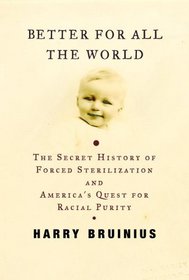Search -
Better for All the World : The Secret History of Forced Sterilization and America's Quest for Racial Purity
Better for All the World The Secret History of Forced Sterilization and America's Quest for Racial Purity
Author:
In Better for All the World, Harry Bruinius charts the little-known history of eugenics in America—a movement that began in the early twentieth century and resulted in the forced sterilization of more than 65,000 Americans. — Bruinius tells the stories of Emma and Carrie Buck, two women trapped in poverty and caught up in a new scien... more »
Author:
In Better for All the World, Harry Bruinius charts the little-known history of eugenics in America—a movement that began in the early twentieth century and resulted in the forced sterilization of more than 65,000 Americans. — Bruinius tells the stories of Emma and Carrie Buck, two women trapped in poverty and caught up in a new scien... more »
ISBN-13: 9780375413711
ISBN-10: 0375413715
Publication Date: 2/21/2006
Pages: 416
Rating: ?
ISBN-10: 0375413715
Publication Date: 2/21/2006
Pages: 416
Rating: ?
0 stars, based on 0 rating
Publisher: Knopf
Book Type: Hardcover
Other Versions: Paperback
Members Wishing: 0
Reviews: Amazon | Write a Review
Book Type: Hardcover
Other Versions: Paperback
Members Wishing: 0
Reviews: Amazon | Write a Review
Genres:
- Politics & Social Sciences >> Government >> Social Policy
- Nonfiction >> Social Sciences >> Discrimination & Racism
- Nonfiction >> Social Sciences >> General
- Nonfiction >> Social Sciences >> Sociology >> Race Relations >> America
- Nonfiction >> Social Sciences >> Sociology >> Race Relations >> General
- Medical Books >> Medicine >> Medical Ethics




